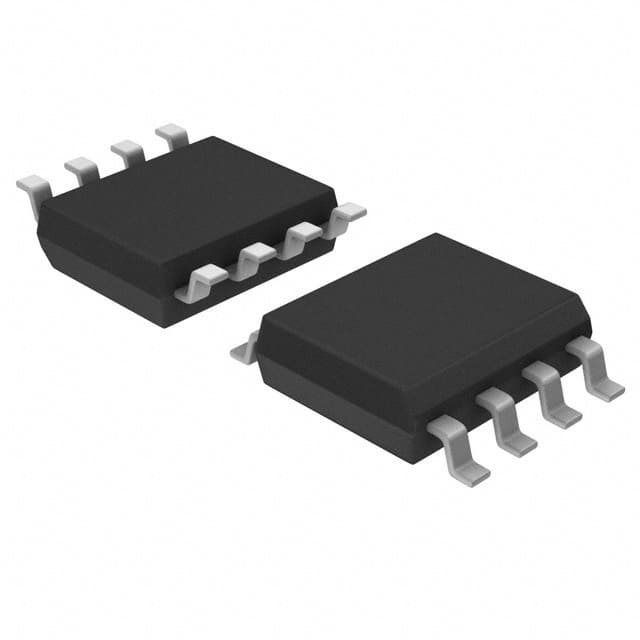SN74LVC2G74DCTRG4
Product Overview
- Category: Integrated Circuit (IC)
- Use: Flip-Flop
- Characteristics: Dual Positive-Edge-Triggered D-Type Flip-Flop
- Package: VSSOP (Very Small Outline Package)
- Essence: This IC is a dual positive-edge-triggered D-type flip-flop designed for 1.65V to 5.5V VCC operation.
- Packaging/Quantity: Tape and Reel, 3000 pieces per reel
Specifications
- Supply Voltage Range: 1.65V to 5.5V
- High-Level Input Voltage: 0.7 x VCC to VCC + 0.3V
- Low-Level Input Voltage: -0.3V to 0.3V
- High-Level Output Voltage: VCC - 0.3V
- Low-Level Output Voltage: 0.3V
- Maximum Operating Frequency: 100MHz
Detailed Pin Configuration
The SN74LVC2G74DCTRG4 has a total of 8 pins:
- Pin 1: Data Input A
- Pin 2: Clock Input A
- Pin 3: Set/Reset Input A
- Pin 4: Ground (GND)
- Pin 5: Output A
- Pin 6: Output B
- Pin 7: Set/Reset Input B
- Pin 8: VCC (Supply Voltage)
Functional Features
- Dual flip-flop with independent set/reset inputs
- Positive-edge-triggered operation
- Wide supply voltage range allows compatibility with various systems
- High-speed operation with maximum frequency of 100MHz
- Low power consumption
- Schmitt-trigger inputs for noise immunity
- Available in small package size for space-constrained applications
Advantages and Disadvantages
Advantages: - Dual flip-flop design provides flexibility in circuit design - Positive-edge-triggered operation ensures reliable data capture - Wide supply voltage range allows compatibility with different power sources - Schmitt-trigger inputs enhance noise immunity
Disadvantages: - Maximum operating frequency may limit its use in high-speed applications - Limited number of set/reset inputs may restrict certain circuit configurations
Working Principles
The SN74LVC2G74DCTRG4 is a dual positive-edge-triggered D-type flip-flop. It operates by capturing the input data on the rising edge of the clock signal. The captured data is then stored in the flip-flop until the next rising edge of the clock.
The set/reset inputs allow for manual control of the output states. When the set input is activated, the corresponding output is forced to a high logic level. Conversely, when the reset input is activated, the output is forced to a low logic level.
Detailed Application Field Plans
The SN74LVC2G74DCTRG4 can be used in various applications, including but not limited to:
- Digital communication systems
- Data storage devices
- Microcontrollers and microprocessors
- Industrial automation
- Consumer electronics
- Automotive electronics
Detailed and Complete Alternative Models
- SN74LVC2G74DCURG4
- SN74LVC2G74DCTR
- SN74LVC2G74DCUTR
- SN74LVC2G74DCUR
- SN74LVC2G74DCU
These alternative models offer similar functionality and characteristics to the SN74LVC2G74DCTRG4, providing options for different package types or quantities.
Word count: 422 words
قم بإدراج 10 أسئلة وإجابات شائعة تتعلق بتطبيق SN74LVC2G74DCTRG4 في الحلول التقنية
Sure! Here are 10 common questions and answers related to the application of SN74LVC2G74DCTRG4 in technical solutions:
Q: What is the SN74LVC2G74DCTRG4? A: The SN74LVC2G74DCTRG4 is a dual positive-edge-triggered D-type flip-flop IC (integrated circuit) with set and reset inputs.
Q: What is the voltage range supported by SN74LVC2G74DCTRG4? A: The SN74LVC2G74DCTRG4 supports a wide voltage range from 1.65V to 5.5V.
Q: What is the maximum operating frequency of SN74LVC2G74DCTRG4? A: The SN74LVC2G74DCTRG4 can operate at a maximum frequency of 100 MHz.
Q: How many flip-flops are there in SN74LVC2G74DCTRG4? A: The SN74LVC2G74DCTRG4 contains two independent D-type flip-flops.
Q: What is the purpose of the set and reset inputs in SN74LVC2G74DCTRG4? A: The set and reset inputs allow for asynchronous control of the flip-flop, enabling the user to set or reset the output state.
Q: Can SN74LVC2G74DCTRG4 be used in battery-powered applications? A: Yes, SN74LVC2G74DCTRG4 is suitable for battery-powered applications due to its low power consumption and wide voltage range.
Q: What is the typical propagation delay of SN74LVC2G74DCTRG4? A: The typical propagation delay of SN74LVC2G74DCTRG4 is around 3.5 ns.
Q: Can SN74LVC2G74DCTRG4 be used in high-speed data transmission applications? A: Yes, SN74LVC2G74DCTRG4 can be used in high-speed data transmission applications due to its fast switching speed and low propagation delay.
Q: What is the package type of SN74LVC2G74DCTRG4? A: SN74LVC2G74DCTRG4 is available in a small SOT-23-8 package.
Q: Are there any special considerations for PCB layout when using SN74LVC2G74DCTRG4? A: It is recommended to follow the manufacturer's guidelines for PCB layout, including proper decoupling capacitors placement and minimizing trace lengths to reduce noise and ensure signal integrity.
Please note that these answers are general and may vary depending on specific application requirements.


